In the Stress-Free Zone of the Bear Creek Nature Preserve
at Casitas de Gila Guesthouses in Southwest New Mexico
that going to the mountains is going home; that wildness is a necessity;
and that mountain parks and reservations are useful
not only as fountains of timber and irrigating rivers, but as fountains of life.
John Muir – 1901
HOW HUMANS CAME TO BE DISCONNECTED FROM NATURE


Current scientific thinking suggests that Modern Humans (Homo sapiens sapiens) began to acquire modern behavioral traits around 50,000 years ago, existing as hunter-gatherer societies up until around 10,000 to 12,000 years ago when some groups began to develop sedentary agriculture. How and what these prehistoric Humans thought about is poorly understood, particularly the question of how they saw themselves relative to the rest of the Natural World in which they lived. With the advent of writing around 5,000 years ago and modern world-wide archaeological and anthropological studies, especially cultural anthropology, we have been able to obtain much greater insight into this question.
In his 2002 book The Lost Language of Plants, Stephen Buhner, herbalist, naturalist, and teacher, presents a synthesis of how a majority of nonindustrial and indigenous peoples thought about Human and Nature connections and relationships. Some of key points of his synthesis are:
- “At the center of all things is Spirit. In other words, there is a central underlying unifying force in the Universe that is Sacred.”
- “All matter is made from this substance. In other words, the Sacred manifests itself in physical form.”
- “Because all matter is made from the Sacred, all things possess a Soul, a Sacred Intelligence or logos.”
- “Parts of Earth can manifest more or less sacredness, just like human beings. A human being can never know when some part of Earth might begin expressing deep levels of sacredness or begin talking to him. Therefore it is important to cultivate attentiveness of mind.”
- “Human beings are only one of the many life-forms of Earth, neither more nor less important than the others. Failure to remember this can be catastrophic for individuals, nations, and peoples. The other life in the Universe can and will become vengeful if treated with disrespect by human beings.”
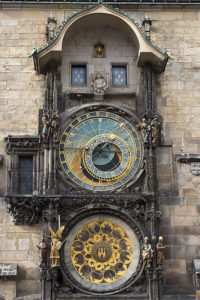

As Buhner summarizes in his book, this view of a Sacred Intelligence at the center of the Universe prevailed in various forms until the concept of a Clockwork Universe began to emerge during the Renaissance (14th to 17th century) and the following Scientific Revolution (16th to 18th century). The scientific paradigm that arose during these early days of science was that the Universe and everything in it is to be thought of as a giant clocklike machine that eventually can be completely understood through the process of scientific reductionism, a method and process whereby something is reduced to smaller and more basic individual parts which can then be further dissected and studied to determine to see how they work.
Gradually overtime, and greatly influenced by the thinking of René Descartes (1596-1650, French philosopher, mathematician, and scientist) the concept of the Universe as Machine evolved to a point where much of science concluded that human beings were the only conscious and intelligent life-form on Earth; and, depending on the scientist’s religious beliefs, that humans were endowed either with or without a soul. Once having reached this state of understanding, as Buhner elaborates in his book, humans thus became separated, isolated, and estranged in Body, Mind and Spirit from the rest of Nature both in thought and deed, setting up most of the environmental and societal problems we struggle with today.
THE RECONNECTION OF HUMANS WITH NATURE
there is society where none intrudes, by the deep sea, and music in its roar;
I love not Man the less, but Nature more.
Lord Byron, British Romantic Poet, 1788-1824
By the beginning of the 19th century the concept of a Universe as Machine prevailed within most scientific thinking in the Western World, along with widespread acceptance of the corollary that humans were to be considered separate from, unconnected to, and even dominant over Nature. The fallacy of this premise began to be challenged in mid- to late-19th century England and other countries, however, with the emergence of what was eventually to become known as the environmental movement. In England, this initial awareness developed around the recognition of the human-caused problem of severe smoke pollution in the atmosphere that was being caused by the Industrial Revolution. For those early environmentalists, there was no question that humans were indeed connected to Nature in that it was obvious that humans were destroying the very air which they breathed, and consequently ruining peoples’ health!
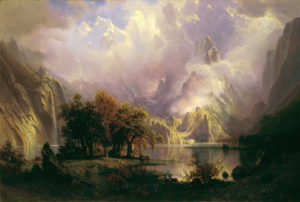
About the same time, an early “Back-to-Nature” conservation movement was also developing in England, promoted by advocates such as John Ruskin who wrote extensively on the value of retaining and living a rural life surrounded by unspoiled Nature. On the other side of the Atlantic in the United States, environmental awareness was simultaneously emerging out of concern for protecting the natural resources of the West, a movement that was especially spurred on through the widely read and appreciated philosophical writings of John Muir and Henry David Thoreau, and American landscape painters such as Albert Bierstadt. Gradually over time, the environmental movement expanded, matured, and spread throughout the world. Embedded deep within the core philosophy of this movement was the recognition that humanity is, indeed, very much connected to and a participant in Nature.
Today, the values and benefits of Humans reconnecting with Nature are being increasingly explored, studied, and researched in a multitude of disciplines concerned with various aspects of well being of the Human Body, Mind, and Spirit.
RECONNECTING WITH NATURE FOR HEALTH OF THE BODY
The old adage “Use It or Lose It” has never been more appropriate than it is today relative to maintaining and improving human health. The key point is that the human body and form were designed to MOVE: fast, over long distances, and for extended periods of time from the earliest days of the species. This was the way it was used through the hunter-gatherer days, the nomadic days, the early agricultural days, until the start of the industrial revolution. Then, as machines began to take over physical work, accompanying human lifestyles became increasingly sedentary, until the ultimate degree of sedentism arrived with the advent of the Digital Age. Exit the Human as Runner; enter the Human as Couch Potato, and long live Screen Time! It is not necessary to describe the effects of this evolutionary—or would we better say devolutionary—journey on the health of the body; millions of us suffer because of it every day and in so many different ways. Thank God for and long live Big Pharma!
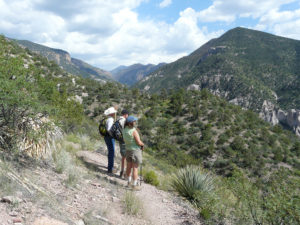
Of course, there have been many efforts to counter this world-wide epidemic of Debilitating Ultimate Digital Sedentism Syndrome, or (DUDSS), in the Human species. Home gym and exercise machines (increasingly digital, of course) are quite the rage, available in various (though mostly high) price ranges. Public gyms now proliferate everywhere offering any number and type of machines, focused on various muscle groups (available in both manual and, of course, digital models). Participation via membership in such gyms is available in various formats and (again, mostly high) price ranges.
There is, however, an alternative prescription for combating DUDSS which has been around for ages, that in recent years has been making a comeback, particularly by cognoscenti of Nature, and that is the humble field of Outdoor Sports Activity Enthusiast (OSAE). While the Digital Age has been making inroads into this time-honored form of Human endeavor, the basic prerequisites for participation have remained the same down through the years, requiring only two ingredients: 1) One Body, and 2) the Will To Move It … the latter sometimes being the hardest to come by. Admittedly the transition for a person suffering from DUDSS TO OSAE can be a challenge. But evidence shows that it is well worth the effort. The great thing about becoming an OSAE person is that all people of all ages can participate according to their ability and needs. Programs can range from a short walk in a public park, to watching birds in a pristine forest, to cross-country running over rough terrain, to mountain climbing. Results will vary with the individual, but frequency, persistence and commitment are primary keys to success. Costs for these programs vary but generally can be done on the cheap — unless you have developed an addiction for the latest in personal designer attire, footwear, or the latest in digital body function monitoring devices (DBFMD), which can drive up your costs exponentially.
RECONNECTING WITH NATURE FOR MENTAL HEALTH AND WELL BEING
While the personal benefits of reconnecting with Nature for physical health are for the most part well known and universally accepted, even within orthodox medicine the concept of reconnecting with Nature as a prescription for improving one’s mental health and general well being has only in recent years become a subject of considerable formal scientific study and research. Folk wisdom and old-time country doctors, of course, have always known of the peace of mind and well being that comes from a quiet interlude or sojourn in a natural setting. Most early sanatoriums were often built in places renowned for their pristine Nature, be it a scenic landscape of mountains, lake, or forest or a special climate or purity of air or water. However, the scientific evidence that a short-term one-on-one encounter of a human being with Nature could bring about an actual measurable physiological or psychological improvement in an individual’s mental health, mood, or sense of well being has only in recent years been forthcoming from mainstream scientific research.
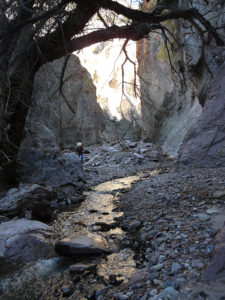
In the past decade there has been a virtual explosion of renewed interest and research regarding the benefits of reconnecting with Nature for mental health and general well being. News articles championing the concept appear with great frequency on the topic, such as this one in the Stanford News: Stanford Researchers Find Mental Health Prescription: Nature. This article reviews two studies by Stanford University researcher Gregory Bratman and his colleagues. The first study compared the effects of a 50-minute walk by 60 participants in a natural versus an urban environment. The results showed that the walk in nature produced a decrease in anxiety, rumination (repetitive thought focused on negative aspects of the self and emotions, a known risk factor for mental illness), and benefits in complex working memory tasks among participants. A second expanded study involving 38 participants compared a 90-minute walk in a natural setting with a 90-minute walk in a high-traffic urban setting that gave similar results, i.e. reduced rumination in the natural setting, plus reduced activity in the subgenual prefrontal cortex of the brain (an area of the brain linked to risk for mental illness and depression). Both of these studies support other related research which reports that people who live in cities have 20% higher risk of anxiety disorders, a 40% higher risk of mood disorders, and are twice as likely to develop schizophrenia as people who live in rural areas. The results of these two studies are highly significant, the Stanford News article reports, in as much as presently more than 50% of the world’s population live in urban environments, a figure that is projected to increase to 70% by 2050.
A recent article in the National Geographic Magazine, 2016, entitled This Is Your Brain on Nature describes several research projects around the world which have shown positive benefits of Nature upon mental health and well being. One project, led by Dr. David Thayer, cognitive psychologist at the University of Utah, involves three-day camping trips in the wilderness where participating students are wired up to a portable EEG machine that records changes in brain waves over the three-day immersion in Nature. The results of his project in many ways mirror the Stanford results, it that they show a positive restorative effect where the brain basically calms down and resets itself so that mental performance and well-being improves.
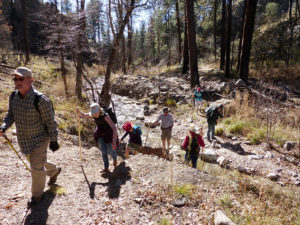
Summaries of additional research into the restorative effects of Nature upon the Mind can be found in a 2013 article in the Atlantic Magazine entitled How Nature Resets Our Minds and Bodies. The article goes into what it is that sets natural environments apart from others, namely the two types of human attention as identified by William James, the great American philosopher and psychologist. One is Directed Attention, the type of attention that rules the day in completing daily tasks in the urban environment, such as driving, writing, tending to business, etc. Directed Attention demands a highly focused attention which tires and depletes the energy of the mind quickly. The other type of attention is Involuntary Attention which requires no mental effort at all and actually is restorative to mental well being, just as food and water restore the body.
When out in Nature it is Involuntary Attention that entrains one’s consciousness, an effortless attention of immersion into the myriad of Nature’s delights and ways … the pretty stone, the falling leaf, the gurgling stream. Psychologists have a name for this mental restorative process resulting from contact with Nature and it is Attention Restoration Theory or ART. This theory was developed by Rachel and Stephen Kaplan in 1989 in their book The Experience of Nature: A Psychological Perspective. A more recent article on the theory, The Restorative Benefits of Nature: Toward an Integrative Framework can be found by doing an Internet search on the title.
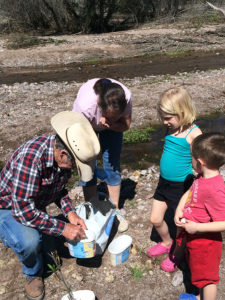
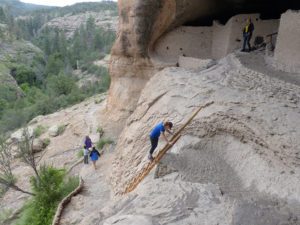
In 2005, an author by the name of Richard Louv coined the interesting term Nature-Deficit Disorder (NDD) in his 2008 book Last Child in the Woods: Saving Our Children From Nature-Deficit Disorder. This book investigates the phenomena of increasing estrangement of children from Nature in a historical context from past to present. The term has caught on and is in wide use today to describe numerous physical and psychological problems that result from a lack of physical and mental connection of both children and adults from the natural world. Louv cites increasing lines of research that investigate a variety of problems that can result from NDD, such as limited respect for immediate natural surroundings, attention disorders and depression, child obesity, and myopia. Primary causes suggested for these problems would include our increasing digital addictions, loss of access to and time spent out in Nature, and parental fears which keep children indoors. Several organizations both in this country and abroad have been formed with the focus of increasing childhood connection with Nature, such as The Children and Nature Network and The No Child Left Inside Coalition.
For those interested in reading further about the connection between Nature to Human Health and Well Being, there are numerous recent books, articles, and reports on the subject. Some which have received favorable reviews would be:
- Vitamin N: The Essential Guide to a Nature-Rich Life by Richard Louv
- Your Brain on Nature by Alan C. Logan
- The Nature Fix: Why Nature Makes us Happier, Healthier, and More by Florence Williams
- For those who would appreciate a more comprehensive and in-depth discussion of this subject, the following report available on line might be also be of interest. In 2010, a large research project was completed for Beyondblue Limited, the National Depression Initiative, a non-profit Health Promotion Charity funded by the Federal, State and Territory Governments of Australia to research the connection between Nature and mental health and well being. The completed report for this research project conducted by Professor Dr. Mardie Townsend and Rona Weerasuriya of Deakin University, Australia, is entitled Beyond Blue to Green: The benefits of contact with nature for mental health and well-being. This comprehensive report (160 pages), although somewhat dated in terms of current research into the subject, is an excellent overview that goes deeply into the history and present trends regarding the scientific background, theory, areas of research, and discoveries regarding Nature and Human mental health and well-being.
RECONNECTING WITH NATURE FOR SPIRITUAL RENEWAL
and break clear away, once in awhile,
and climb a mountain or spend a week in the woods.
Wash your Spirit clean.
John Muir – 1915

Spirit, as in human spirit, and spirituality, are prime examples of words in common everyday usage that have various meanings to those that hear, speak, or read them. Traditionally, the terms have had a deeply religious context, with specific meanings tied to the various religions of the world and their accompanying Diety belief systems. In many of these religions, the connection of spirituality to the world of Nature is considered an important and often-referenced concept in the scriptures.
In modern times, there has been a gradual separation of the term spirituality from a strictly organized religious context as stated in the increasing espoused phrase “Spiritual but not religious”, or SBNR, to a context where the emphasis in meaning is placed on 1) the subjective experience of a sacred, unknowable, unseen, or ineffable (that which cannot be put into words) dimension, and 2) the deepest values, principles, and learnings by which people live, which typically include a focus on personal psychological growth and improvement, a quest for an ultimate understanding of the meaning and purpose of life, pursuit of spiritual experience, or discovering one’s inner self, being, or dimension.
William James in his 1902 seminal book, The Varieties of Religious Experience: A Study in Human Nature, was not particularly interested in the theology and organizational aspects of religion, but rather investigated and wrote about various aspects of direct, personal religious experience. Two important parts of this work included discussions of 1) the reality of the unseen aspects of the Universe, for which he criticized science for ignoring, and 2) the two main features of mystical experience, namely its Ineffability – where “no adequate report of its contents can be given in words”, and its Noetic Quality – where “mystical states seem to those who experience them to be also states of knowledge. They are states of insight into depths of truth unplumbed by the discursive intellect”.
Today, the concepts of the SBNR and James’ ineffability and noetic quality of mystical experience are integral parts of a growing ecological movement known as Ecospirituality, a concept that connects the science of ecology with spirituality, and brings together religion and environmental activism. Ecospirituality has been defined as “a manifestation of the spiritual connection between human beings and the natural environment”(Nature). Ecospirituality includes many of the tenets of Deep Ecology, an ecological and environmental philosophy that explores the importance of recognizing and preserving the complex inter-relationship of all organisms of which humans are just one part; and Ecopsychology, a branch of psychology that studies the relationship between human beings and the natural world.
If one considers the combined philosophies of ecospirituality, deep ecology, and ecopsychology it seems to suggest an emerging overall worldview that is in many ways similar to the major points presented above in Stephan Buhner’s synthesis of how nonindustrial and indigenous peoples of the past thought about Human and Nature connections and relationships. Hopefully the emerging worldview is a more enlightened one, having evolved from an interconnected Universal Consciousness and intelligence that infuses all life and matter where humans are just one part, to an inanimate, clock-like, Mechanistic Universe where humans are the sole conscious life form , and is now slowly returning to a more inclusive and connected worldview where Humans are no longer separated from the rest of Nature.
THE BEAR CREEK NATURE PRESERVE
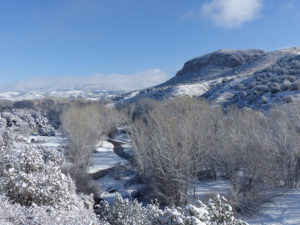
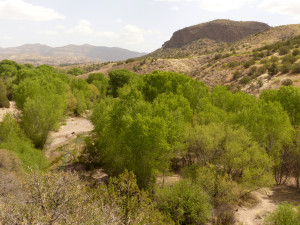
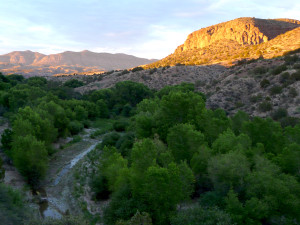
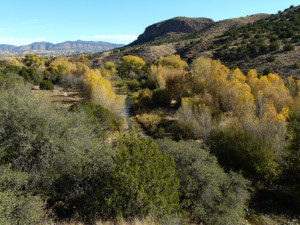
HISTORY
The Bear Creek drainage is roughly 25 miles long, extending west from its headwaters in the town of Pinos Altos, 5 miles north of Silver City, to empty into the Gila River between the communities of Gila and Cliff. From prehistoric days up until the late 1800s Bear Creek served as a major route for east-west travel because of the presence of year-round water and plentiful game, and a constant, gentle change in elevation. Up until the discovery of gold in and around Pinos Altos in 1860, followed by open-range ranching in the 1870s and 80s, Bear Creek flowed through pristine, wild, mountainous country. With the exception of a continuing presence of low-intensity cattle ranching, and minor placer mining in the early 1900s, the greater portion of the Bear Creek drainage has remained in an essentially pristine state with little human development to speak of, with approximately 65-70% of its course flowing through Gila National Forest, Bureau of Land Management, and State of New Mexico land.
The Bear Creek Nature Preserve had its beginning in 1998 with the purchase of 70 acres of land bordering a half-mile stretch of Bear Creek about 5 miles upstream from its confluence with the Gila River by the present owners, Becky and Michael O’Connor, for the development of Casitas de Gila Guesthouses. Originally, this parcel of land was part of the vast Hooker Ranch, a pioneer ranch dating from the 1880s, that encompassed some 100,000 acres. Prior to the Hooker operation, all of this portion of Southwest New Mexico was considered Apache Indian territory, who continued an active and much-feared presence over the landscape from sometime in the late 16th or early 17th century until 1886 when Geronimo surrendered. Preceding the nomadic Apache, around a thousand years ago, the Native American Mogollon Culture lived in several villages along Bear Creek, farming the river bank terraces, growing the “Three Sisters” crops of maize (corn), squash, and beans.
In 1998, the section of Bear Creek which was to become the Bear Creek Nature Preserve, especially the active floodplain, was in a very degraded state due to extreme overgrazing by feral cattle which had been allowed to roam over the property for about 15 years following the termination of the Hooker Ranch operation. While a few mature and very old Cottonwoods, Sycamores, Willows, and Gray Oaks lined the sides of the floodplain, the creek banks and adjacent floodplain were extensively channeled by repetitive flooding, covered with coarse gravel, and almost devoid of any vegetation taller than the new owners. Soon after purchase of the Casita property, the north and south ends of the property along the creek were fenced and the Bear Creek Nature Preserve was born.
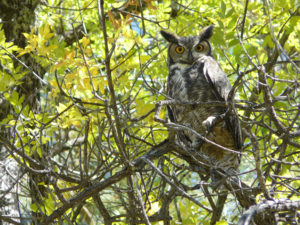
The restoration of the Bear Creek Nature Preserve along Bear Creek is now beginning its 19th year, and what amazing changes have taken place there during that time! The floodplain is now covered with a mature mixed forest of Cottonwood, Sycamore, and Willow with many cottonwood exceeding 60 feet in height. The indigenous understory vegetation is more diverse and lush, providing ample shelter, food, and safety for animals, birds, and reptiles. For the past three years, breeding pairs of Great Horned Owls, Cooper’s Hawks, and a large flock of wild Merriam’s Turkeys have taken up residence. Last Spring a returning amateur ornithologist from England reported 91different species of birds on the Bear Creek Nature Preserve and nearby surrounding areas during a one-week stay at the Casitas.
Animal life is also diverse and plentiful. All of the small mammals of Southern New Mexico including the rare and rarely-seen White Nosed Coatimundi are resident, as well as a small herd of Mule Deer. Occasional visitors to the Preserve include Rocky Mountain Bighorn Sheep, Couger, and Black Bear. Many varieties of reptiles live on the property, and during the summer the creek is a haven for a wide variety of butterflies and insects. Small minnows and frogs abound both in and along the creek. The restoration of harmony and balance of Nature is evident everywhere.
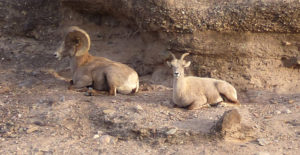
Over the years, between 2003 and 2010, additional acreage was acquired on both sides of Bear Creek, enlarging the Bear Creek Nature Preserve to a total of 265 acres, much of which is accessible to Casita guests over a network of 6 miles of maintained trails, ranging from foot paths over a variety of terrain to a challenging hike up Paradise Overlook Mountain where a 360° view looks out into the Gila Wilderness to the north and the newly established 6,000-acre New Mexico Game and Fish Wildlife Preserve directly adjoining the Casitas de Gila property to the east.

The Bear Creek Nature Preserve is a very special landscape of unique geology, diverse habitats, and topography including juniper- and mesquite-covered hillsides, Bear Creek Canyon and Creek, adjoining dry washes, and a 1,000-foot range in elevation. With the exception of the Casita buildings clustered on the edge of Bear Creek Canyon, the ¾ mile private gravel road leading into the property, a short dirt road leading to a small horse coral and vegetable garden down near the Creek, and the six miles of foot trails, the rest of the property is undeveloped and is reserved untouched for the plants, birds, animals, reptiles and fish that choose to inhabit and visit the Preserve.
RECONNECTING WITH NATURE IN THE STRESS-FREE ZONE
OF THE BEAR CREEK NATURE PRESERVE
Reconnecting with Nature is easy in the stress-free zone of the Bear Creek Nature Preserve for people of all ages and physical abilities at any time of year. The Casitas are situated along the very edge of Bear Creek Canyon, 80 feet below. All that is necessary is to step outside one’s Casita, plop down in a chair overlooking the the Gila Wilderness to the north, the close-by rocky crags of Turtle Rock, and the small mountains of North and South Peak rising up from the Creek to the east, relax and, presto, you will soon be connected! Best times are early morning when, depending on the time of the year, you can watch the Sun rise over Turtle Rock or North and South Peaks, and late afternoon when the setting Sun in the west illuminates those same mountains with a gradually-changing hue of yellow to orange to red, just before lights out. Or, if your visit is timed just right, a full or near-full moon rising over those same mountains is transcendent.
The silence of Nature is pervasive throughout the Preserve. When walking the trails along Bear Creek or reclining in the hammock at the foot of the big Cottonwood, the only sounds are those of Nature: the murmuring of water passing over rocks, the hoot of the owl, the call of the Gamble’s Quail or White-winged Dove, or the rustle of the wind in the Willows and the Cottonwoods overhead. No personal effort required, just relax and Nature will make the Connection.
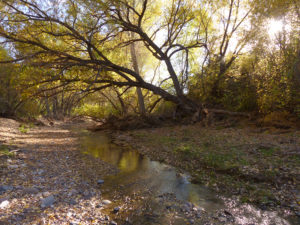
Have a camera?
Unlimited connections are there for the taking.
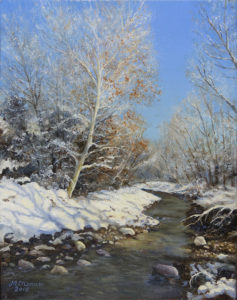
Like to sketch or paint? A thousand or more subjects await your enchantment and connection!
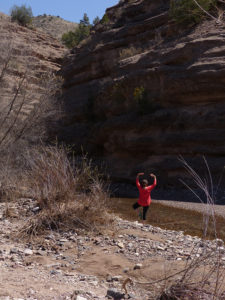
Is meditation, yoga, or chi gong your path? Scattered over the Preserve and awaiting your discovery are numerous hidden spaces perfect for an ultimate connection.
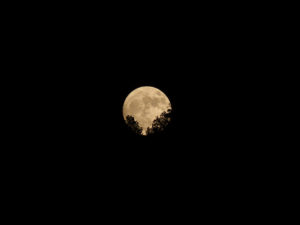
Is the starry firmament above your source of connection? if so, bring your telescape and your camera, for the night skies over the Preserve are absolutely some of the clearest and darkest skies in the continental United States.
Poetic inspiration surrounds you in the Bear Creek Nature Preserve
John Muir




